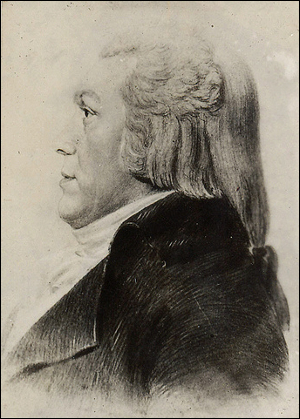1738-1801
Chief Justice of the New York Supreme Court of Judicature, 1779-1790
Richard Morris, third son of Hon. Lewis Morris, Jr., Judge of the New York Court of Vice-Admiralty, was born on August 15, 1730, at the family manor, Morrisania. He was the younger brother of Colonel Lewis Morris, a signer of the Declaration of Independence, half-brother of statesman and diplomat, Gouverneur Morris, and grandson of former Chief Judge Lewis Morris.
Morris graduated from Yale College in 1748, and commenced his legal studies. Following his admission to the bar on April 29, 1752, he set up a law office and quickly became recognized as an outstanding lawyer. Upon his father’s death in 1762, Morris was commissioned by Governor Monckton as Judge of the Court of Vice-Admiralty of New York, a court that had jurisdiction over New York, Connecticut, and New Jersey in all maritime causes, the proceedings of the court being the same as in the High Court of Admiralty in England. Because Great Britain was then involved in hostilities with other powers, many of the cases before the court dealt with doctrines of capture and prize — whether ships captured in conflicts could be retained as lawful prize. The court also heard cases based on breach of any Parliamentary act relating to the trade and revenues of the Colony.
In 1775, because Morris had given his allegiance to the colonists in their conflict with the Crown, he resigned as Judge of the Court of Vice-Admiralty. When he refused Governor Tyrone’s request to remain in office, the Governor issued special orders for the seizure and burning of Mount Fordham, Morris’s country seat in Westchester County. On July 31, 1776, the New York Provincial Convention unanimously appointed Morris to be Judge of the High Court of Admiralty but he was forced to decline the office due to the ongoing danger to his family and property.
On March 4, 1778, the Assembly appointed Morris to fill a vacancy in the State Senate, and he continued to hold office as a senator until October 22, 1779, when he was appointed the second Chief Justice of New York, a position that had become vacant when John Jay accepted an appointment as United States Ambassador to the Spanish Court. As Chief Justice, Morris was a member of the Council appointed by the Legislature to carry on the government of the southern parts of the State until the Legislature could be convened. In 1788, he represented New York county at the New York State Convention to Ratify the Federal Constitution.
On October 19, 1789, when John Jay took the oath of office as Chief Justice of the Supreme Court of the United States, it was administered by Richard Morris as Chief Justice of the New York Supreme Court of Judicature. Although Chief Justice Morris’s tenure on the New York Supreme Court of Judicature predates the existence of the law reports, his opinions in the Court of Vice-Admiralty of New York attest to his legal acumen. Richard Morris remained Chief Judge of the New York Supreme Court of Judicature until September 1790, when he reached the age of sixty, the mandatory retirement age under the New York Constitution. He retired to his Mount Fordham estate (now Bronx County Community College), and died there on April 11, 1810.
Sources
W. W. Spooner. “The Morris Family of Morrisania.” The American Historical Magazine, vol. 1.
The National Cyclopaedia of American Biography, vol. 12.
The Supreme Court of New York under the Constitution of 1777: Biographies of the Chief Justices. 23 Medico-Legal Journal 94 (1905-1906).

